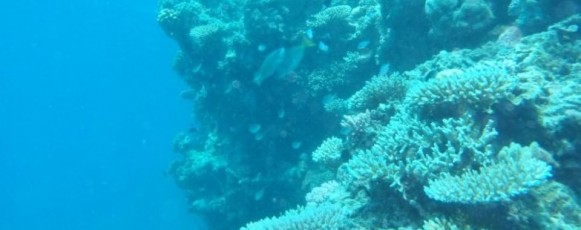Why do corals compete for space on the reef?
Coral reefs are a beautiful and exotic attraction for many people around the world, and serve as an important economic benefit to the countries that have them on their coastlines. Many people do not realise that corals are actually colonies of animals (not plants) and are usually associated with clear, warm water in the tropics. Divers that are in the closest contact with coral reefs get the opportunity to observe how much life is actually supported by them. They provide shelter and safe habitats for many fish species and there is also an ongoing battle between the different corals. They are constantly competing with each other for light, temperature and clear water, 3 essential ingredients for their survival.
Light is the main factor that drives competition between corals. They live in a mutualistic partnership with zooxanthellae, a form of plankton that uses photosynthesis to create energy and this energy is in turn used by the coral to grow and provide the zooxanthellae with protection. This relationship is the reason that corals need to compete. Zooxanthellae can be free living in the ocean, but when they leave the coral exposed, this is when it becomes bleached. This bleaching can occur when the water temperature increases or decreases by as little as 1 degree Celsius beyond what is optimal for the corals. If the zooxanthellae return to the coral within 1 week then the partnership is restored and the corals are protected again, however anything longer than the week and the coral will die. Turbulent water is also detrimental to corals because it stirs up sediment that can block out the light from the corals.
All of these factors occur naturally over time, but human activities have increased their severity within in past century and the most detrimental impact is the rising acidity of the oceans caused by too much man-made carbon dioxide. Ocean acidification is seen as the greatest threat to corals worldwide, but other threats include dynamite fishing for tropical fish and trawling of the seabed that completely destroys the reefs, some of which take 100’s of years to grow. All over the world the scientist are building coral gardens to try and increase the amount of reefs to preserve them for future generations.
References
– Connell J. H. Terence P. Hughes C. C. Wallace J. E. Tanner K. E. Harms A. M. Kerr. 2004. A Long-Term Study of Competition and Diversity of Corals Ecological Monographs, Vol. 74, No.2 179-210
– Glynn, P. W. 1996. Coral reef bleaching: facts, hypotheses and implications. Global Change Biol. 2: 495-509.
– Hughes T. P., A. H. Baird, D. R. Bellwood, M. Card, S. R. Connolly, C. Folke, R. Grosberg, O. Hoegh-Guldberg, J. B. C. Jackson, J. Kleypas, J. M. Lough, P. Marshall, M. Nystrom, S. R. Palumbi, J. M. Pandolfi, B. Rosen, J. Roughgarden. 2003. Climate Change, Human Impacts, and the Resilience of Coral Reefs. Science Vol: 301
– Wilkinson, C. 1996. Global change and coral reefs: impacts on reefs, economies and human cultures Global Change Biology vol.2, 547-558





